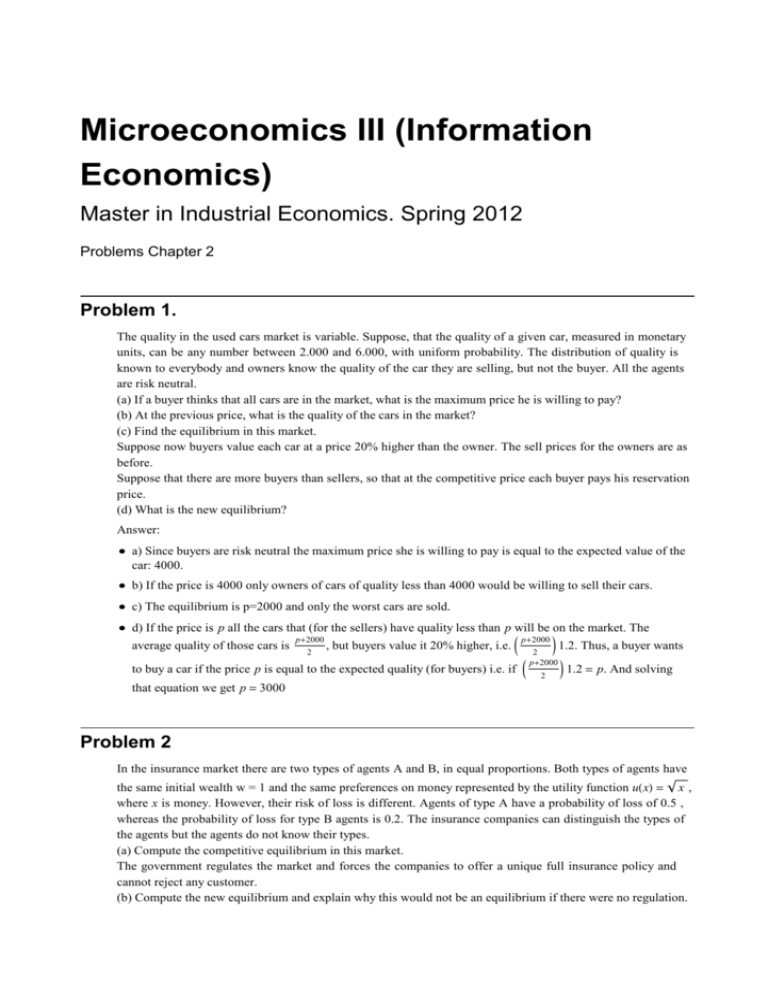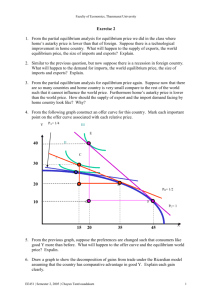Answers to set 2.
advertisement

Microeconomics III (Information Economics) Master in Industrial Economics. Spring 2012 Problems Chapter 2 Problem 1. The quality in the used cars market is variable. Suppose, that the quality of a given car, measured in monetary units, can be any number between 2.000 and 6.000, with uniform probability. The distribution of quality is known to everybody and owners know the quality of the car they are selling, but not the buyer. All the agents are risk neutral. (a) If a buyer thinks that all cars are in the market, what is the maximum price he is willing to pay? (b) At the previous price, what is the quality of the cars in the market? (c) Find the equilibrium in this market. Suppose now buyers value each car at a price 20% higher than the owner. The sell prices for the owners are as before. Suppose that there are more buyers than sellers, so that at the competitive price each buyer pays his reservation price. (d) What is the new equilibrium? Answer: è a) Since buyers are risk neutral the maximum price she is willing to pay is equal to the expected value of the car: 4000. è b) If the price is 4000 only owners of cars of quality less than 4000 would be willing to sell their cars. è c) The equilibrium is p=2000 and only the worst cars are sold. è d) If the price is p all the cars that (for the sellers) have quality less than p will be on the market. The average quality of those cars is p+2000 2 , but buyers value it 20% higher, i.e. J p+2000 to buy a car if the price p is equal to the expected quality (for buyers) i.e. if J that equation we get p = 3000 N 1.2. Thus, a buyer wants 2 p+2000 2 N 1.2 = p. And solving Problem 2 In the insurance market there are two types of agents A and B, in equal proportions. Both types of agents have the same initial wealth w = 1 and the same preferences on money represented by the utility function uHxL = x , where x is money. However, their risk of loss is different. Agents of type A have a probability of loss of 0.5 , whereas the probability of loss for type B agents is 0.2. The insurance companies can distinguish the types of the agents but the agents do not know their types. (a) Compute the competitive equilibrium in this market. The government regulates the market and forces the companies to offer a unique full insurance policy and cannot reject any customer. (b) Compute the new equilibrium and explain why this would not be an equilibrium if there were no regulation. (c) Discuss the efficiency in each situation and, if possible, compare them. 2 whereas the probability of loss for type B agents is 0.2. The insurance companies can distinguish the types of the agents but the agents do not know their types. (a) Compute the competitive equilibrium in this market. answersProblemCh2AdveSel2.nb The government regulates the market and forces the companies to offer a unique full insurance policy and cannot reject any customer. (b) Compute the new equilibrium and explain why this would not be an equilibrium if there were no regulation. (c) Discuss the efficiency in each situation and, if possible, compare them. Answers: è a) In this case firms will “reveal” the types of agents. They will offer different contracts to different types. Say that the loss is equal to 1 (the precise number is not important). Type A agents will get full inusrance with the contract (1,0.5) (the amount of insurance is 1 and the premium is 0.5). Type B agents will get full insurance with the contract (1, 0.2). Notice that firms can’t cheat, i.e. if a firms offers to a type B person the contract corresponding to the type A person, so that the firm makes a positive profit, other firms will offer the type B contract and “steal” that consumer (perfect competition) è b) In this case firms will use the average probability, 0.35, in their contracts. They will offer the contract (1, 0.35). Agents will accept it. è c) we will discuss it in class Problem 3 (Separating equilibrium in the model where “The principals compete for the agents”. Based on Exercise 22b in Microeconomics by Thomas Nechyba ). Suppose a perfect competitve insurance market. Agents face the possibility of a bad outcome in which their consumption is x1 and the possibility of a good outcome in which their consumption is x2 . Suppose further that there are two consumer types, consumers of type ∆ facing outcome x1 with probability ∆ and consumers of type Φ facing outcome x1 with probability Φ. We assume that ∆<Φ. Each type knows the risk he or she faces but the insurance companies do not which type any given individuals represents. Insurance companies know the fraction Γ of the population of type ∆ (and the remaining fraction (1-Γ) is of type Φ). INsurance companies offer insurance contracts that are defined by an insurance premium p and and insurance benefit b (if a consumer purchases an insurance contract Hp, bL, his or her consumption in the good state is Hx2 - pL while his or her consumption in the bad state is Hx1 + b - pL. Suppose that the utility function of the agents is uHxL = Α lnHxL. Suppose that x1 = 10, x2 = 250, ∆ = 0.25 and Φ = 0.5. è Find the contracts Hp∆ , b∆ L, IpΦ , bΦ M that can be a separating equilibrium in this market. è Can you say something about how the equilibrium insurance contract for the low risk type ∆ changes as the high type becomes riskier. i.e. as Φ increases? Answer : We know that the type Φ agent will get (actuarily fair) full insurance. This implies a consumption level of HH1 - ΦL x2 + Φx1 L with certainty. The full insurance utility for type Φ is U Φ = ΑlnHH1 - ΦL x2 + Φx1 L. The indifference curve that gives all combinations of b and p such that Φ type is indifferent to the full insurance outcome is then given by ΦΑlnHx1 + b - pL + H1 - ΦL ΑlnHx2 -p)=ΑlnHH1 - ΦL x2 + Φx1 L we can solve for b to get b=J H1-ΦL x2 + Φ x1 Hx2 -pLH1-ΦL N 1Φ + p - x1 Next we need to find the intersection of the above indifference curve with the line p = ∆b that represents the menu of actuarily fair insurance contracts for type ∆ agent. Thus we need to solve J H1-ΦL x2 + Φ x1 Hx2 -pLH1-ΦL N 1Φ + p - x1 =4p which can be written as 1302 250-p + p - 10 = 4 p and using the quadratic formula we get the equilibrium insurance contract for type ∆ (take the first root) p = 21.30 and b = 4 p = 85.20 answersProblemCh2AdveSel2.nb 0.5 * 250 + 0.5 * 10 sol1 = SolveA 3 2 H250 - pL0.5 + p - 10 - b 0, pE; Plot@80.5 * b, 0.25 * b, p . sol1@@1, 1DD<, 8b, 10, 400<, AxesLabel ® 8b, p<D p 200 150 100 50 100 200 300 400 b You can check that as we increase Φ the equilibrium contract for type ∆ is such that the premium and the benefit both go down. The next plot shows the equilibrium contracts for type ∆ when Φ goes from Φ=1 to Φ=0.25: pes = TableAFindRootA H1 - ΦL * 250 + Φ * 10 1Φ H250 - pLH1-ΦL + p - 10 - 4 * p 0, 8p, 0<E, 8Φ, 0.25, 1, 0.05<E; fi = Table@i, 8i, 0.25, 1, 0.05<D; ListPlot@ Table@8Hp . pes@@iDDL 4, p . pes@@iDD<, 8i, 1, Length@pesD<D, AxesLabel ® 8b, p<D p 60 50 40 30 20 10 50 100 150 200 b 4 answersProblemCh2AdveSel2.nb TableForm@Table@8fi@@iDD, Hp . pes@@iDDL 4, p . pes@@iDD<, 8i, 1, Length@pesD<D, TableHeadings ® 8None, 8"Φ", "b", "p"<<D Φ 0.25 0.3 0.35 0.4 0.45 0.5 0.55 0.6 0.65 0.7 0.75 0.8 0.85 0.9 0.95 1. b 240. 139.006 117.038 103.647 93.6108 85.1939 77.6058 70.4122 63.3362 56.174 48.7524 40.9008 32.4265 23.0809 12.4949 0. p 60. 34.7515 29.2594 25.9117 23.4027 21.2985 19.4014 17.603 15.834 14.0435 12.1881 10.2252 8.10664 5.77022 3.12373 0. More problems: Problem 4. (exercise 1, page 160, of the book by Ines Macho Stadler and Perez Castrillo) Problem 5. (exercise 2, page 160, of the book by Ines Macho Stadler and Perez Castrillo) Problem 6. (exercise 3, page 161, of the book byInes Macho Stadler and Perez Castrillo) Problem 7. (exercise 4, page 161, of the book by Ines Macho Stadler and Perez Castrillo) Problem 8. (exercise 6, page 162, of the book by Ines Macho Stadler and Perez Castrillo) Solutions: See the textbook









